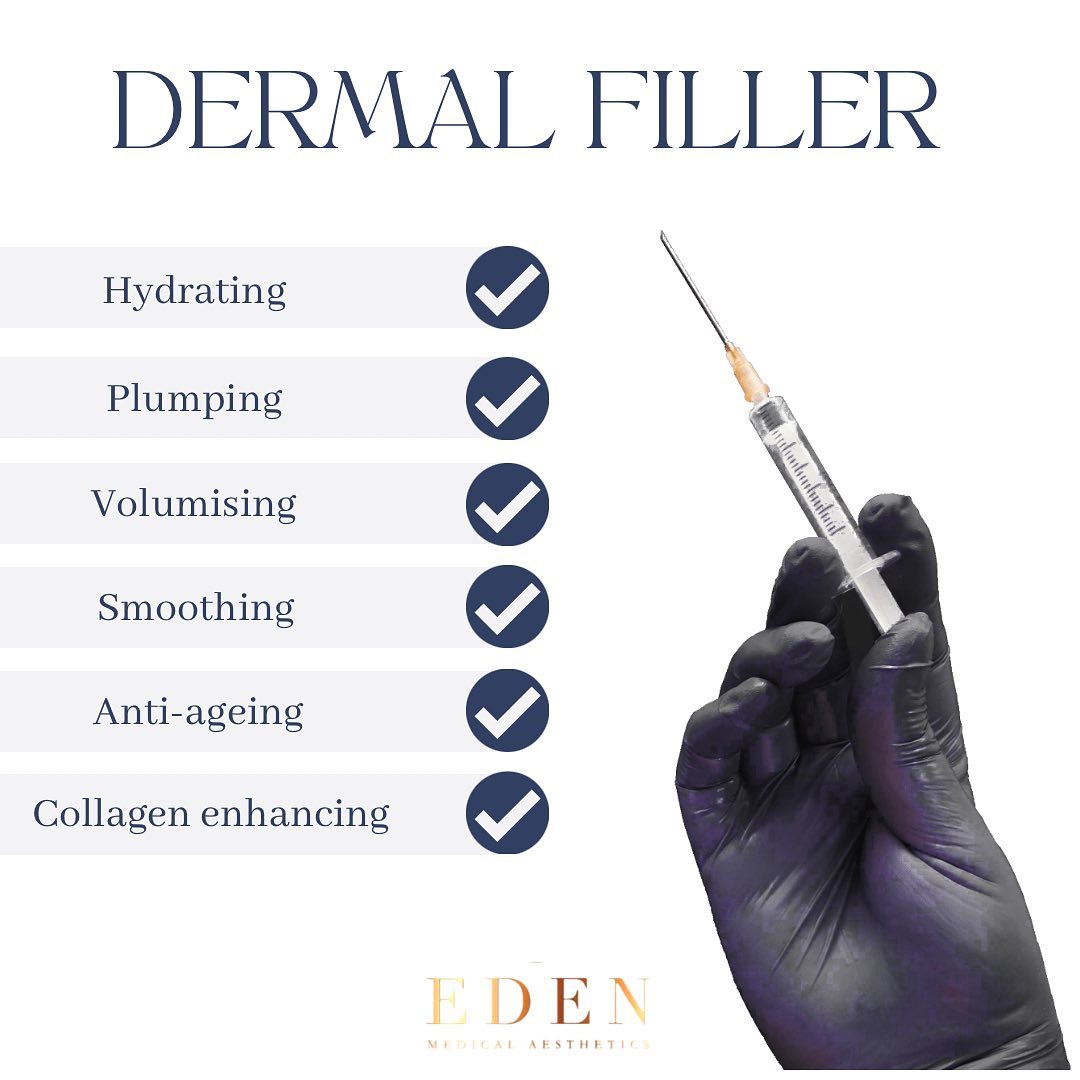Dermal Fillers
Dermal fillers are a minimally invasive procedure which can plump thin lips, enhance shallow contours, soften facial creases, remove wrinkles and improve the appearance of scars. As we age our face naturally loses fat, the facial muscles are then working closer to the skin which results in the appearance of lines. Dermal fillers are our “go to” treatment.

This treatment is extremely effective as a response to the early signs of ageing or as part of a more extensive facial rejuvenation. Since Dermal fillers also contain hyaluronic acid which occurs naturally in the body, results look authentic. You can expect Dermal fillers to last for 12 – 18 months.
Frequently Asked Questions
What are fillers?
Fillers are anti-ageing injections that contain a gel-like substance, most often hyaluronic acid, which can give the skin a rejuvenated look. When injected into the skin, dermal fillers quite literally ‘fill out’ lines and wrinkles, volumize hollow, sunken areas of the face, and define and reshape facial features.
Where can fillers be used?
Dermal fillers are used to treat static lines (which remain on the face even when it’s relaxed) and for facial contouring. Treatment areas include:
• Tear troughs (eye bags)
• Nose (liquid rhinoplasty)
• Cheeks
• Marionette lines (which extend from the corners of the mouth down to the chin)
• Nasolabial folds (lines either side of the nose)
• Lips
• Chin and jawline
• The backs of the hands
• The neck
How do dermal fillers work?
When filler is injected into the skin, it smooths out fine lines and wrinkles and plumps out areas which have lost volume. Essentially, dermal fillers work in place of diminished fat, collagen, and elastin.
Hyaluronic acid (the most common filler substance) makes a great injectable as it attracts and holds onto lots of water - this water then helps create the plumping effect underneath the skin.
What are fillers made of?
The most common types of dermal fillers are made from hyaluronic acid, including the popular brands Juvéderm and Restylane. Hyaluronic acid is often favored over other filler substances because it can be dissolved (with an enzyme called hyaluronidase) if anything goes wrong with the treatment or if the client does not like the results.
Another plus of hyaluronic acid is that it is a naturally occurring molecule found in the skin, which means it is a safe material that is well-received by the body.
How often can I have treatment?
When the effect of the anti-wrinkle injection wears off, the wrinkles will always return to their pre-treatment state. Treatments can be repeated at a minimum of three-monthly intervals, but the effects may last longer for some individuals, especially if they have had previous treatments to the same area.
Are there any side effects of fillers?
The dermal filler side effects are pretty minimal and usually disappear soon after the treatment - they typically last a few days. They include things like swelling, redness, and minor bleeding near the injection points. You might also experience some bruising, but applying an arnica cream to the area can help keep this at bay.
If any of these symptoms persist, contact your practitioner for advice.
What is the recovery time of fillers?
There is no downtime following a filler treatment, so you will be able to resume your plans as usual. And any side effects you encounter should clear up within a few days of your treatment.
But you might want to clear your calendar of important events until any signs of redness, swelling, and bruising have disappeared.
How long do dermal fillers last?
When hyaluronic acid-based dermal fillers are used, results typically last for 12 -18 months. But their exact longevity will vary from person to person as it depends on how quickly each individual metabolizes the filler.
Aftercare Advice
The following aftercare advice is essential to help reduce the risk of treatment
complications, to improve your comfort/healing and to help achieve the best results
from treatments.
• Immediately after the treatment, you might notice some temporary redness, swelling
and bruising at or around the injection site. This is common.
• These effects typically resolve within 2-3 days (although treatments to the lips may
result in swelling lasting up to 7 days).
• A cool compress or an ice pack (on for 20 minutes per hour) for 4-6 hours post injections
can help reduce the redness and swelling and helps to minimize any bruising.
• The use of Arnica tablets or gel may be useful for bruising.
• If redness and swelling persist beyond 3 days, becomes worse or is accompanied by
other symptoms, such as increased pain or fever, you should contact us straight away.
• You should avoid exposing the treated area to intense heat (from the sun, steam
rooms/saunas, tanning beds etc.) or manipulation (facials, massages, waxing, facial
aesthetic treatments) for 2 weeks post-treatment.
• After dermal fillers, you must avoid lasers to the treatment area for 4 weeks.
• If you have had a previous outbreak of facial cold sores, the injection of dermal filler can
lead to a recurrence. Cold sore history should be discussed prior to treatment and the
use of anti-viral medication prior to injections may be helpful. New cold sore eruptions
are also possible, even if you have not experienced an outbreak before. Please let us
know if any sores or lesions that occur in or around the treatment area, so that early
intervention and treatment can be used to minimize discomfort and complications.
• Make sure you avoid taking aspirin, St John's Wort, high dose vitamin E and non-
steroidal anti-inflammatory (NSAID'S) medications such as Nurofen or ibuprofen, for one
week following treatment. These medications may increase bruising and bleeding at the
injection site.
• Avoid exercise and alcohol for 24 hours post treatment.
Cost of Dermal Fillers
Dermal filler prices start from £200 but price varies depending on treatment area and amount/type of filler required. Price will be confirmed on consultation.